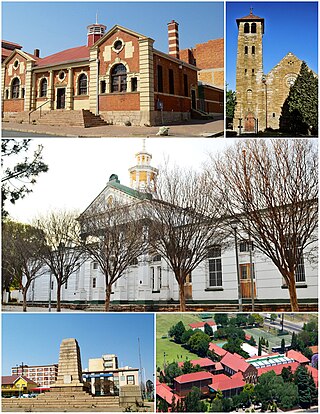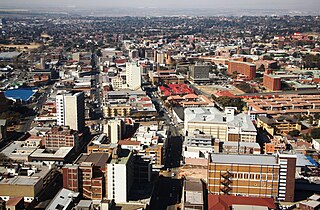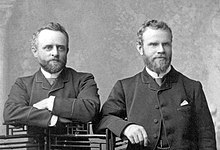History
In February 1886, the discovery of gold on the Witwatersrand in South Africa led to the founding of the city of Johannesburg shortly thereafter. The farm Elandsfontein was about ten kilometers east and belonged to a farmer, Sarel Meyer. Simmer & Jack, a trading company in Harrismith which ran a shop in Chrissiesmeer had, a year earlier, acquired half of Meyer's farm. In September 1886 John Jack registered the mining rights on the farm to Simmer & Jack.
With the founding of the company in August 1887 Simmer and Jack took on board the entrepreneur Sir George Farrar, whose family imported drilling equipment to South Africa. Also added to the team was Harry Struben who from 1884 had run a small gold mine in Roodepoort. The town of Germiston was established and named after John Jack's birthplace in Scotland.
The politician and entrepreneur Cecil Rhodes, who had made a fortune in the diamond business, saw the gold finds as another opportunity and began, with his partner Charles Rudd, to buy up farms, mines and mining rights on the Witwatersrand. To finance their activities they founded the London-based company 'The Gold Fields of South Africa Ltd.' Simmer & Jack was one of the first mines to draw their attention.
It soon became apparent that the gold deposits were very large indeed, but that gold could only be extracted from the pyrite with great difficulty and expense using contemporary technology. Contact with the Scottish chemist John Seward MacArthur, brought news of the cyanide process and made possible the success of the South African gold mining industry.
The initial years of the company were against a background of political turmoil (Jameson Raid, Second Boer War), various economic difficulties and huge investments. By 1888 the company had built a crushing or stamp mill with 25 stampers. The plant was further expanded to 100 stampers by 1895 and 320 stampers by 1899. Gold production at the mine reached its peak in 1922. By 1935 Simmer & Jack had processed 27,000,000 tons of rock and extracted 7.8 million ounces of gold for a gross profit of £10 million. In 1965 Goldfields sold their shares as the gold deposits were almost exhausted. The original mine was closed down in 1969.

The Witwatersrand is a 56-kilometre-long (35 mi), north-facing scarp in South Africa. It consists of a hard, erosion-resistant quartzite metamorphic rock, over which several north-flowing rivers form waterfalls, which account for the name Witwatersrand, meaning "white water ridge" in Afrikaans. This east-west-running scarp can be traced with only one short gap, from Bedfordview in the east, through Johannesburg and Roodepoort, to Krugersdorp in the west.

Johannesburg is a large city in Gauteng Province of South Africa. It was established as a small village controlled by a Health Committee in 1886 with the discovery of an outcrop of a gold reef on the farm Langlaagte. The population of the city grew rapidly, becoming a municipality in 1898. In 1928 it became a city making Johannesburg the largest city in South Africa. In 2002 it joined ten other municipalities to form the City of Johannesburg Metropolitan Municipality. Today, it is a centre for learning and entertainment for all of South Africa. It is also the capital city of Gauteng.

The Witwatersrand Gold Rush was a gold rush that began in 1886 and led to the establishment of Johannesburg, South Africa. It was a part of the Mineral Revolution.

Boksburg is a city on the East Rand (Ekurhuleni) of Gauteng province of South Africa. Gold was discovered in Boksburg in 1887. Boksburg was named after the State Secretary of the South African Republic, W. Eduard Bok. The Main Reef Road linked Boksburg to all the other major mining towns on the Witwatersrand and the Angelo Hotel (1887) was used as a staging post.

Germiston, also known as kwaDukathole, is a city in the East Rand region of Gauteng, South Africa, administratively forming part of the City of Ekurhuleni Metropolitan Municipality since the latter's establishment in 2000. It functions as the municipal seat of Ekurhuleni, hosting the municipal council and administration.

Krugersdorp is a mining city in the West Rand, Gauteng Province, South Africa founded in 1887 by Marthinus Pretorius and Abner Cohen. Following the discovery of gold on the Witwatersrand, a need arose for a major town in the west of the reef. The government bought part of the Paardekraal farm and named the new town after the Transvaal president, Paul Kruger. Krugersdorp no longer has a separate municipal government after it was integrated into Mogale City Local Municipality along with surrounding towns. It is now the seat of government for Mogale City.
Ferreirasdorp is an inner-city suburb of Johannesburg, South Africa located in Region F of the City of Johannesburg Metropolitan Municipality.
Salisbury Claims is a suburb of Johannesburg, South Africa. It is located in Region F of the City of Johannesburg Metropolitan Municipality.
Village Main is a suburb of Johannesburg, South Africa. The suburb lies less than a kilometre south of the Johannesburg CBD. Once mining land, now consists of light industry and one of the city's main freeway, M2 runs through the suburb. It is located in Region F of the City of Johannesburg Metropolitan Municipality.

Harmony Gold is the largest gold mining company in South Africa. Harmony operates in South Africa and in Papua New Guinea. The company has nine underground mines, one open-pit mine and several surface operations in South Africa. In Papua New Guinea, it has Hidden Valley, an open-pit gold and silver mine and a 50% interest in the Morobe Mining Joint Venture, which includes the Wafi-Golpu project and extensive exploration tenements. Outside the joint venture, Harmony's own exploration portfolio focuses principally on highly prospective areas in Papua New Guinea.

The Mineral Revolution is a term used by historians to refer to the rapid industrialisation and economic changes which occurred in South Africa from the 1860s onwards. The Mineral Revolution was largely driven by the need to create a permanent workforce to work in the mining industry, and saw South Africa transformed from a patchwork of agrarian states to a unified, industrial nation. In political terms, the Mineral Revolution had a significant impact on diplomacy and military affairs. Finally, the policies and events of the Mineral Revolution had an increasingly negative impact on race relations in South Africa, and formed the basis of the apartheid system, which dominated South African society for a century. The Mineral Revolution was caused by the discovery of diamonds in Kimberly in 1867 and also by the discovery of gold in Witwatersrand in 1886. The mineral mining revolution laid the foundations of racial segregation and the control of white South Africans over black South Africans. The Mineral Revolution changed South Africa from being an agricultural society to becoming the largest gold producing country in the world.
JCI or Johannesburg Consolidated Investment Co. Ltd. was founded in 1889 by the British entrepreneur Barney Barnato. JCI was a major force in South African mining for over 100 years. Using his investments in the Kimberley diamond fields, particularly his 25% share in De Beers, Barnato foresaw the value of and invested in the potential of the Witwatersrand gold mines. At first he bought small but rich mines near Germiston – the New Primrose, named after his daughter, and others in the same region.

Mining in South Africa was once the main driving force behind the history and development of Africa's most advanced and richest economy. Large-scale and profitable mining started with the discovery of a diamond on the banks of the Orange River in 1867 by Erasmus Jacobs and the subsequent discovery of the Kimberley pipes a few years later. Gold rushes to Pilgrim's Rest and Barberton were precursors to the biggest discovery of all, the Main Reef/Main Reef Leader on Gerhardus Oosthuizen's farm Langlaagte, Portion C, in 1886, the Witwatersrand Gold Rush and the subsequent rapid development of the gold field there, the biggest of them all.
The Minerals Council South Africa is a South African mining-industry employer organisation. Its members include famous South African mining houses such as Anglo American, De Beers, Gold Fields and Harmony. In its current form, it was founded in 1968 as the Chamber of Mines, a South African wide organization. Prior to that year, it has its early origins as the Transvaal Chamber of Mines in 1887, then evolved over many years reforming as the Witwatersrand Chamber of Mines in 1889, the Chamber of Mines of the South African Republic from 1897, Transvaal Chamber of Mines from 1902 and lastly from 1953 until 1967 as the Transvaal and Orange Free State Chamber of Mines. On 23 May 2018, the South African Chamber of Mines rebranded themselves as the Minerals Council South Africa.

Rand Water is a South African water utility that supplies potable water to the Gauteng province and other areas of the country and is the largest water utility in Africa. The water is drawn from numerous sources and is purified and supplied to industry, mining and local municipalities and is also involved in sanitation of waste water.
Colonel Ignatius Philip Ferreira, was a South African soldier, fortune hunter, miner and farmer of Portuguese descent. He is more commonly known for having the earliest gold mining camp on the Witwatersrand named after him called Ferreirastown (Ferreirasdorp), which was on the edge of the farm Randjeeslagte soon to be proclaimed as the site of a new town called Johannesburg.

Harry Struben born Hendrik Wilhelm Struben aka Henry William Struben was the brother of Frederick Struben, who together managed the first gold-mining operation on the Reef. They were the sons of Johan Marinus Struben, a South African Republic official, and his wife Frances Sarah Beattie of Scottish origin. Harry was born during a yacht trip along the Lower Rhine. His family emigrated to Pietermaritzburg in Natal in 1850, and moved to Pretoria five years after.
Hans Sauer was an Orange Free State born medical doctor, lawyer, adventurer and businessman. He is regarded as a Rand Pioneer, arriving in Johannesburg in 1886 shortly after the discovery of gold and was the town's first district surgeon. He is linked with the creation of Rhodesia.
Johannes Petrus Meyer was a politician, member of the Volksraad of the South African Republic, mining entrepreneur, and farmer; he is the man for whom Meyerton and Meyersdal are named.
Charles Butters was an American metallurgist, engineer and mine owner. A graduate of the University of California, he moved to Southern Africa in 1890 to construct a chlorination plant for Hermann Eckstein & Company. Whilst there Butters pioneered the use of the gold cyanidation process for extracting the metal from low grade ore, which opened up new deposits in Witwatersrand. He also developed other methods that increased extraction efficiency. Butters left Eckstein in 1894 to jointly found a new firm, the Rand Central Ore Reduction Company. He joined the Johannesburg Reform Committee in 1895, a group of mostly immigrants to South Africa who demanded, among other things, a stable constitution, an independent judiciary, and a better educational system; he participated in the Jameson Raid, a botched attempt against the South African Republic, and was fined $2,000.











